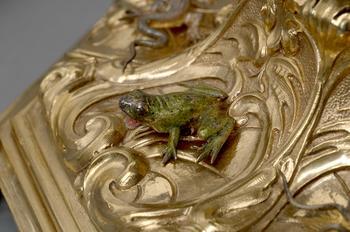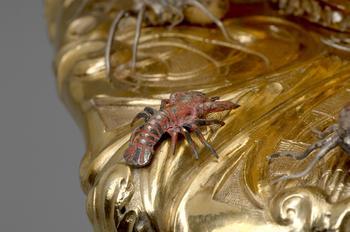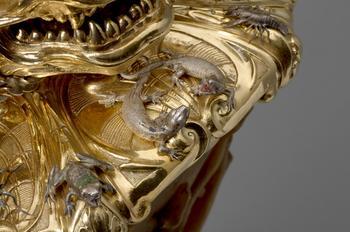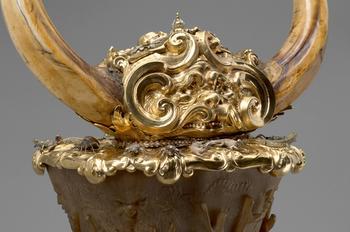Rhinoceros Horn Goblet with Lid
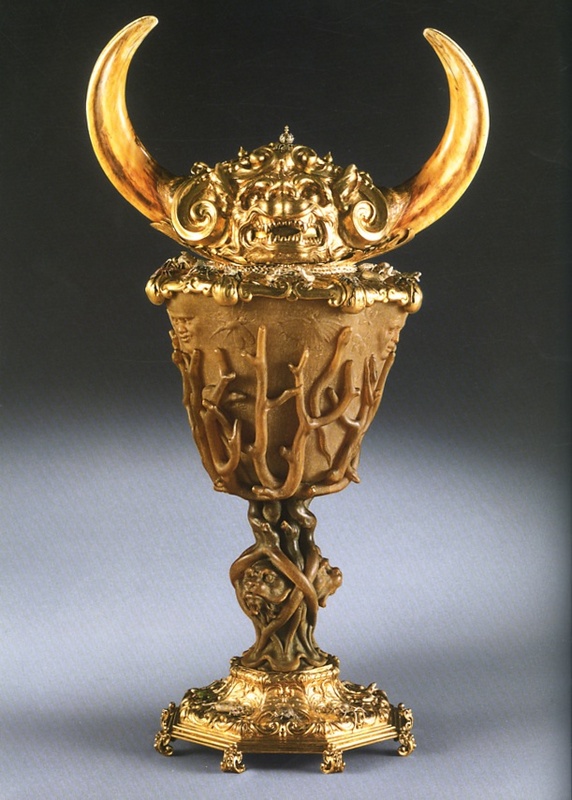
Nikolaus Pfaff, Rhinoceros Horn Goblet with Lid, 1611. Horn of a white rhinoceros (Ceratotherium simum), tusks of an African warthog, silver gilt, partly painted, 59.7 x 27.5 cm. Kunsthistorisches Museum, Vienna, inv. no. KK 3709.
Baring its fangs, a gilded creature confronts the viewer with two monstrous horns erupting out of the sides of its head. Its body serves as a goblet, and dissolves in form into a recognizable stem characteristic of a drinking vessel. At its “foot”is a gilded silver base, tying the two extremities together via material (head and feet). Constructed of white rhinoceros horn (ceratotherium simum), a material believed to be apotropaic (note 1), the body and stem are carefully sculpted with numerous natural motifs. Canine-like faces peer out from between the various chiasmus formed by intertwining coral branches around the stem, while above, coral branches grow upwards around the body of the cup. Interestingly, coral was also believed to be potent in warding off evil (note 1); one apotropaic material is sculpted to resemble another, perhaps as a kind of “double-protection” (note 2).The “horns”of the beast are made of African warthog tusks, a material that (along with the rhinoceros horn) could only have been acquired from a foreign source. However, the tusks were not recognized as warthog tusks, but rather believed to be horns of a dragon or wyvern –adding to the magic quality of the goblet.
Perched around the rims of the golden lid and base rest small reptiles, insects, amphibians, and crustaceans. Legs splayed and mouths agape, the creatures seem to have crawled up from the underworld and recall the tradition of memento mori, symbolic reminders of death and decay.
In fact, they also recall the tradition of life-casting, in which actual specimens are used as molds to attain perfect copies of nature’s creations. Ironic, then, are the lively depictions of such petrified organisms. For they seem to be bustling and issuing forth from the goblet itself, enhancing the boggling and somewhat disturbing effect of the goblet.
Upon closer inspection, it is clear that these small figurines are in fact arranged symmetrically (as is the rest of the cup), and contained within their own radial quadrant. On the body of the goblet are faint counterparts in light relief, interspersed between emerging human visages. According to Paulus Rainer, these faces serve as “symbols of the healing power of nature and the cosmos” (note 3).
The back of the goblet features what appears to be the same monstrous face, yet here it seems to be restrained by swirling voluted; the threat glaring out from the front of the goblet is thus suppressed in the back.
Order and disorder, healing and menacing, live and dead (note 4), the cup features a series of dichotomous notions at play with one another.
Notes:
note 1. Martin Kemp, “‘Wrought by No Artist’s Hand’: The Natural, the Artificial, the Exotic, and the Scientific in Some Artifacts from the Renaissance,” in Art, science, and witchcraft in early modern Holland: Jacques de Gheyn II (1565-1629), ed. Claudia Swan, (New York, NY: Cambridge University Press, 2005),
note 2. Paulus Rainer, “Rhinoceros Horn Goblet with Lid,” in Habsburg treasures: at the Kunsthistorisches Museum, Vienna, ed. Sabine Haag and Franz Kirchweger. (New York: Vendome Press, 2013), 202.
note 3. Rainer, “Rhinoceros Horn Goblet with Lid,” 202.
note 4. Coral appealed particularly to collectors as an ambiguous combination of animal, mineral and vegetable. This ambiguity of alive or dead is extremely appropriate in this particular goblet. See Patrick Mauriès, Cabinets of Curiosities, (New York: Thames & Hudson, 2002), 89.
